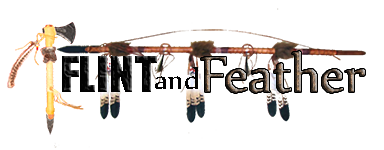Introduction to the Flint and Feather Rules!
 Flint and Feather is a skirmish level set of tabletop rules for use with the official Flint and Feather Miniatures. The figures are 28mm scale and have been sculpted by Bob Murch. Bob himself put this project in motion when he read the book the Orenda by Joseph Boyden, Oneworld Publications: 2013. This story follows Bird an elder and one of the Huron Nation’s great warriors and statesmen. The story outlines his trips to meet the French in Quebec City and his interaction with the members of his tribe, a Jesuit missionary named Christophe and culminates in the sacking of the village by Iroquois warriors. This book inspired Bob to begin sculpting. Soon Howard Whitehouse was contacted and contracted to create a set of rules to play tabletop games that represent this era. So far Howard and his cohort Roderick Robertson have developed a Beta play test set of rules which have been farmed out to a few individuals. Some sample figures have also been presented including a give away at Council Fires 2014 in Cambridge, Ontario in September. Playtest games have been run at several conventions around the country. We intend to have playtest games at Historicon in July, so look for us there.
Flint and Feather is a skirmish level set of tabletop rules for use with the official Flint and Feather Miniatures. The figures are 28mm scale and have been sculpted by Bob Murch. Bob himself put this project in motion when he read the book the Orenda by Joseph Boyden, Oneworld Publications: 2013. This story follows Bird an elder and one of the Huron Nation’s great warriors and statesmen. The story outlines his trips to meet the French in Quebec City and his interaction with the members of his tribe, a Jesuit missionary named Christophe and culminates in the sacking of the village by Iroquois warriors. This book inspired Bob to begin sculpting. Soon Howard Whitehouse was contacted and contracted to create a set of rules to play tabletop games that represent this era. So far Howard and his cohort Roderick Robertson have developed a Beta play test set of rules which have been farmed out to a few individuals. Some sample figures have also been presented including a give away at Council Fires 2014 in Cambridge, Ontario in September. Playtest games have been run at several conventions around the country. We intend to have playtest games at Historicon in July, so look for us there.
The rules are designed for skirmish level games. From the Introduction, "Flint and Feather is a set of game rules
for tribal warfare between the nations of the Great Lakes region in the era
prior to the settlement of Europeans." Each player controls a War Band of between six and fifteen models, with multiplayer games running into the fifty figure count. A point system is used to design your specific models with choices ranging from Great Warriors - the leader of your War Band, down thru to Striplings which represent youths getting their first taste of combat. As can be expected there are many choices in designing characters to fit your own play style. Traits come in Advantages, which have a positive affect on the game, and Disadvantages which may cause your warriors some difficulties.
The game uses an action system to move through a turn. Each warrior in your War Band can perform two actions in your turn. However, each player gets an opportunity to react, with some of his models during the opponents turn. This reaction, or interrupting the
sequence of the your opponent’s turn, is
an important aspect of Flint
and Feather. As one player moves his
models, the other will not just be sitting and waiting for his turn but he will be on the lookout for chances to shoot at his enemy. He may also have forces ready to attack from
ambush, or models that might need to pull back from a dangerous place. These reaction moves provide an important aspect of fluidity to the game and requires players to focus and stick to their plan through some chaotic struggles.
Another exciting aspect of the rules is the close combat system utilized by the rules. The rules use stone/paper/scissors type choice system with dice rolls added for realism.Great Warriors and Companions, two types of key figures, get to choose what maneuver they will use while other models roll randomly. Learning which maneuver, or outwitting your opponent is a key aspect to the combat section of the game.
Finally, once the on table action is complete the system moves to an experience and reputation phase. Here you can trade captives, build your War Band by adding new warriors and build your models by adding advantages to them. We are looking forward to play testing these campaign rules. Next onto our first play test experience.




Tanner's "Atlas of Great Lakes Indian History" is a great resource for the history. Can you recommend a good painting reference? I figure I can always use paintings from guys like Griffing as inspiration, but I wondered what Mr. Murch used for inspiration.
ReplyDeleteI've listed several useful Osprey books on my Flint & Feather web page. I've also written an article on painting Iroquoian warriors. The pdf of that is also on the page.
ReplyDeleteThe main thing to remember is that in this period there is no trade cloth or European supplied paints of dyes. Neutral colours should be the norm.
http://pulpfigures.com/huron_iroquois_war/
Thanks! I have those Ospreys, but somehow had missed your pdf. I grew up on the site of an Erie village that was wiped out by the Iroquois, so I can't wait to get my hands on these figures!
ReplyDelete